
|
|

October 5, 2007
WSAY/WRTK/WXXI 1370, Rochester, NY
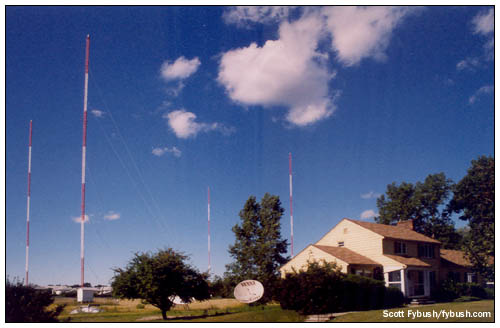 Welcome
back to another exciting season of Tower Site of the Week - and
thanks for your patience during our busy summer travel schedule!
We have one more trip still upcoming (North Carolina and Virginia,
around the NAB Radio Show at the end of September), but we're
excited about all the great tours we'll be sharing with you in
the months to come.
Welcome
back to another exciting season of Tower Site of the Week - and
thanks for your patience during our busy summer travel schedule!
We have one more trip still upcoming (North Carolina and Virginia,
around the NAB Radio Show at the end of September), but we're
excited about all the great tours we'll be sharing with you in
the months to come.
We'll take you to some big AM signals (WBBM, WSCR, KSL), some unusual arrays (how about an AM directional array with I-90 running right through the middle?), some prominent FM/TV mountaintops (Boise's Deer Point, Las Vegas' Mount Arden), not to mention the fields of Iowa, the FMs of Utica, and many more.
This week, though, we continue our look at some sites that are much closer to home - and in this case, we circle around once again to a site that's particularly close to your editor's heart, inasmuch as he works there (or at least for the station that broadcasts from there!)
We've featured Rochester's AM 1370 in previous installments of Site of the Week, but never with interior photos, and certainly never with historic interior photos, which come to us courtesy of two people with ties to the station: Dave Mason, now of Clear Channel San Diego, who worked there in the sixties, and Bob Bittner of WJIB in Boston, who visited there in the early seventies when he was a student at the Rochester Institute of Technology.
History? Oh my, yes, and in droves: When WSAY took to the airwaves in 1936 (some sources say early 1937), it was Rochester's third radio station, and a far distant third at that, behind established players WHAM and WHEC. (The former was Stromberg-Carlson's 50 kilowatt clear-channel flagship, while the latter had the CBS affiliation and ownership ties to the city's two daily newspapers.)
WSAY was a standalone signal, owned by an eccentric inventor named Gordon P. Brown and operating initially with just 100 watts on the "graveyard" channel of 1210 kHz from studios in, and a longwire antenna on, the Taylor Building on East Main Street in Rochester. (The WSAY studios were on the second floor, I'm told, and therein lies a family connection: your editor's grandparents operated a drapery business on the ground floor of the building in the late forties and early fifties, and family members recall WSAY staffers coming into the shop to warm up during a strike against the station sometime in that era.)
WSAY moved to 1240 in the NARBA realigment of 1941, and a few years later it received a construction permit to move up to 1370, initially with 1000 watts day and night. With the war intervening, it took a few years for Brown to be able to build the three-tower array, and it may well be that WSAY operated on 1370 from the Taylor Building location for a bit until the new transmitter site was ready. (How do we know this? WGVA in Geneva, about 40 miles to the southwest, signed on in 1947 on that same 1240 frequency, but the FCC's antenna structure registration records show the current towers with a 1950 construction date, though that may be unreliable.)
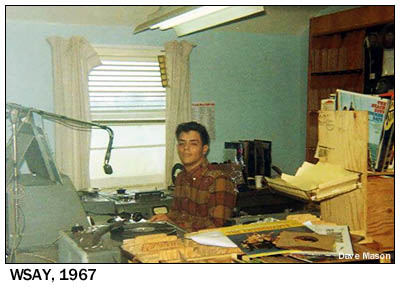 |
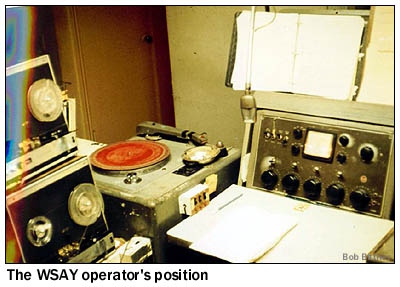 |
In any event, we know that by the very early fifties, WSAY was transmitting from the site shown at the top of the page, at 560 French Road in what was then a rural area near the Barge Canal in the town of Brighton, eight miles or so south of downtown Rochester. The transmitter building looked like a suburban house for good reason: Brown was said to have believed that if the station failed, he could at least sell the house.
Around 1955, WSAY received one more upgrade: the station went from 1000 to 5000 watts, DA-N, reconfiguring the three-tower in-line array into a four-tower rhombus. (I'm told, but have never gone bushwacking to confirm this, that two of the current four towers are original from the first array, while the piers for the old third tower can still be seen in the weeds near the transmitter building.)
Not long afterward, WSAY decamped from its Taylor Building studios into new offices at 250 East Avenue, with the studios moving to the Brighton transmitter site.
It was from there that some of the strangest radio ever heard on Rochester's commercial airwaves spilled forth over the next two decades or so. As Brown became older and even more eccentric, his sights were reportedly set on a television license, and the radio station took a back seat. The East Avenue offices were never completed, I'm told - while the first floor contained the usual sales and management offices, the second floor was framed in for unbuilt radio studios and a big space for the "WSAY-TV" that never came to pass. (Brown was one of more than a dozen applicants for Channel 13 when it was assigned to Rochester in the late fifties, held a small stake in the interim consortium that was formed to put the eventual WOKR on the air in 1962, and was bought out by the late sixties.)
In the meantime, while the city's other stations went through several generations of technological and programming improvements, WSAY turned into a weird combination of antique technology and ahead-of-its-time formatics. From Bob Bittner, we get a series of photos that show just how odd this radio station in a house was: in one room downstairs, the classic RCA BTA-1L that probably signed on the French Road site, by then in aux duty, supplanted by the BTA-5G that is still there today as a backup - and then upstairs, in a room that could have passed as a bedroom, the air studio, such as it was.
There's enough material in the reminiscing of WSAY veterans like Dave Mason to fill an entire tribute website (someday...), but suffice it to say that anyone who had to work with those "Rondine Junior" turntables and play spots (what few there were) off those boxes of 3" reels will never forget the experience. (And, yes, that's a crystal microphone hanging over the whole affair...in 1971!)
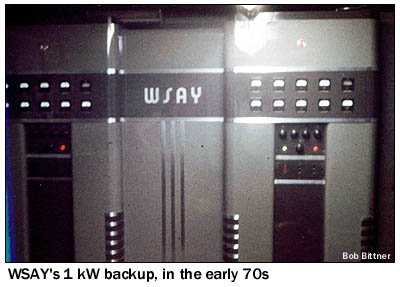 |
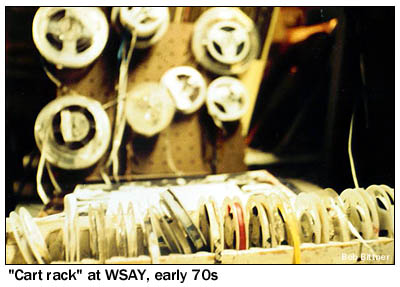 |
WSAY's top-40 format from the sixties had by then morphed into an "anything goes" underground rock sound of the sort that would have been avant-garde even for an FM station - but it was meant only to keep the needles moving until 6 PM, when the rock was replaced by the Rosary Hour that was the station's financial mainstay for most of those years. The pay was miserable, and turnover was frequent, which is why Brown didn't let the jocks use their own names, instead hanging on to the "Mike Melody," "Jerry Jack," etc. school of "house names" that had probably become passe sometime around 1956.
(Somewhere along the way, Brown also put WNIA 1230 on the air in Cheektowaga, near Buffalo, and it operated very much the same way, complete with suburban-house-cum-transmitter-site, for decades.)
By the late seventies, with even the progressive rock audience having decamped to FM, WSAY changed format to country for Brown's final years of ownership. In 1980, he sold the station to Lew Dickey Sr., who closed down the downtown offices and moved the entire operation out to Brighton.
Under Dickey (whose son, Lew Jr., visited the station as a youngster and would later go on to run today's Cumulus group), WSAY began to more closely resemble a "real" radio station. A new studio addition was built on the east side of the building, where Brown had once had a ramp down to the basement garage where he stored his 1948 Lincoln (you can't make this stuff up!). The old studio gear from upstairs reportedly ended up at the curb, replaced by modern gear in a nice (for 1980) carpeted-wall cluster of studios that included a news booth, a control room, a talk studio and a production room. The old BTA-1L went out (I'd love to know where it went!), replaced by a new (or possibly lightly used) Harris MW-5 along what became a carpeted hallway leading down to the new studios.
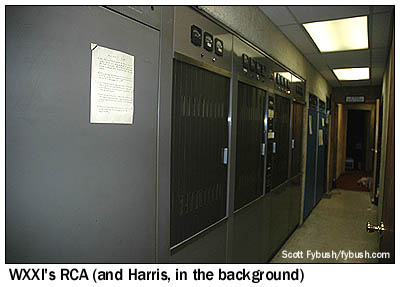 |
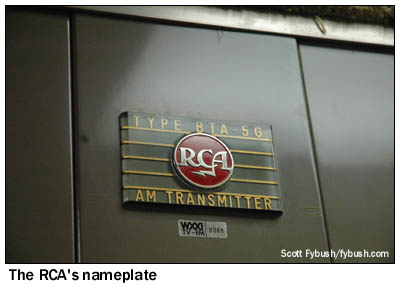 |
The "new" full-service WSAY hired away some of WHAM's top talent in a bid for respectability, though the move was short-lived, doomed in part by the bizarre reputation the station had acquired during Brown's ownership. The WSAY calls finally disappeared on Sept. 15, 1982, replaced by WRTK ("Rochester TalK") and a new format that leaned heavily on ABC's Talkradio network, thanks to the big satellite dish that sprouted next to the building. (After an early flirtation with Mutual, Brown had run the station as an independent for most of his time there.)
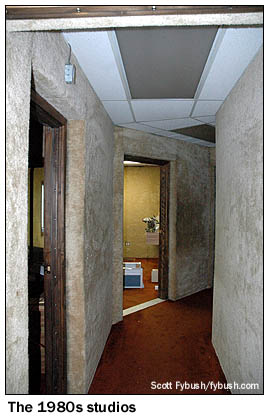 It
was in that incarnation that your editor first wandered over
from the middle school next door to see what the place looked
like, and even then it looked more like a house than a radio
station. To the left of the front door, in what was probably
designed to be a dining room, was a big room that was used as
a sales office, while to the right were more offices and, in
the addition, a newsroom. A door from there led to the transmitter
hallway and down to the studios.
It
was in that incarnation that your editor first wandered over
from the middle school next door to see what the place looked
like, and even then it looked more like a house than a radio
station. To the left of the front door, in what was probably
designed to be a dining room, was a big room that was used as
a sales office, while to the right were more offices and, in
the addition, a newsroom. A door from there led to the transmitter
hallway and down to the studios.
That's the news booth at left (seen in more recent years, when these rooms have been used mainly for storage), and the old control room beyond it. The talk studio sat to the right, separated from the control room by a big window, and the production room was just behind that carpeted wall all the way on the right. (One imagines there must have been a healthy flight of trade-out carpet store ads on WSAY around the time these rooms were built!)
By 1983, the talk was gone and satellite country (from the long-defunct Transtar service) was in place - and by the spring of 1984, WRTK was gone, as Dickey put the station up for sale and Rochester's public broadcaster, WXXI-TV/FM, had made the acquisition of 1370 the focus of a major fund-raising drive.
After a month or so of silence, 1370 came back on the air July 2, 1984 as WXXI(AM), carrying news from NPR, CBC and AP Radio and a nice mixture of jazz and blues in the afternoon and evenings (thus allowing WXXI-FM on 91.5 to go all-classical), with programming originating from the old WRTK studios on French Road until new studios could be built at WXXI's downtown headquarters at 280 State Street.
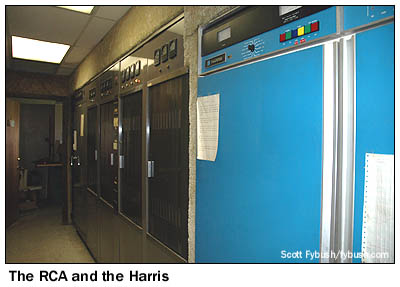 Those
"temporary" State Street studios - an L-shaped configuration
of control room, talk studio and production room surrounding
a newsroom bullpen -went into service around 1986 and remained
in use, substantially unchanged, for almost two decades thereafter.
As for French Road, it became a temporary home for the new Brighton
Volunteer Ambulance corps, then around 1988 the new home for
the Reachout Radio reading service WXXI operated. (Your editor
spent some time there around 1990 as a volunteer reader for the
service, working out of the old WRTK talk studio.)
Those
"temporary" State Street studios - an L-shaped configuration
of control room, talk studio and production room surrounding
a newsroom bullpen -went into service around 1986 and remained
in use, substantially unchanged, for almost two decades thereafter.
As for French Road, it became a temporary home for the new Brighton
Volunteer Ambulance corps, then around 1988 the new home for
the Reachout Radio reading service WXXI operated. (Your editor
spent some time there around 1990 as a volunteer reader for the
service, working out of the old WRTK talk studio.)
Reachout, too, moved downtown within a few years, leaving the French Road building to become rental office space. For the last few years, it's sat mostly vacant, and is likely to be razed eventually, with the transmitters being moved into a new structure on site. (Even the towers could move someday; they were reconfigured in the nineties in a bid to alleviate some of the deep nulls that make nighttime 1370 reception iffy in the growing suburbs east and west of the city, and WXXI has long owned a parcel of land further south that was once eyed as a new transmitter site for the station.)
And we'll close with a few pictures of the State Street studios, where your editor eventually came to toil, beginning in 2003, as a part-time news anchor and jack-of-all-trades: that's yours truly, in 2004, working the board in the waning days of the "temporary" AM studio, and a shot of the new studios that went into use late in 2004. It's a long way, indeed, from the days of Gordon P. Brown, 3" reels of spots and the Rosary Hour!
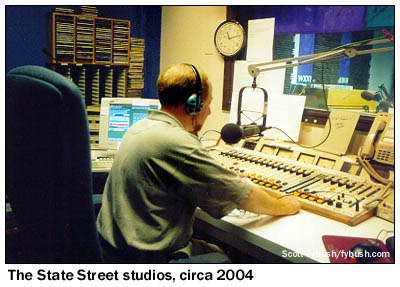 |
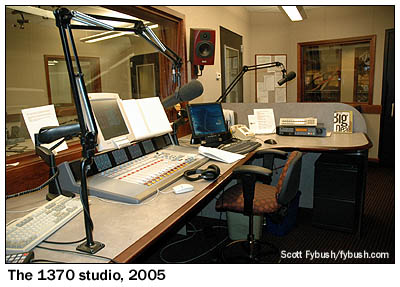 |
Tower Site Calendar 2008 is here! Visit the Fybush.com Store now and get your calendar before the price goes up in just a few days!
- Previous Site of the Week: WNYR/WLGZ 990, Rochester
- Next Week: Rochester's WHAM 1180 and WHTK 1280
- Site of the Week INDEX!
- How can you help support Site of the Week? Click here!
- Submit your suggestions for a future Site of the Week!
